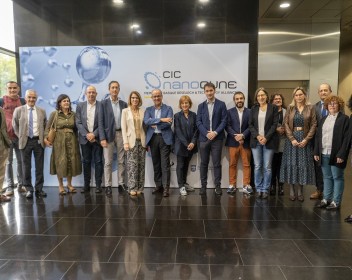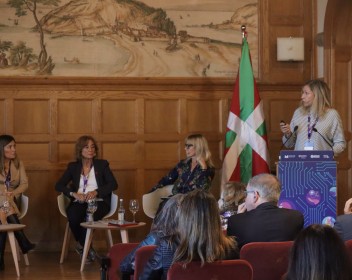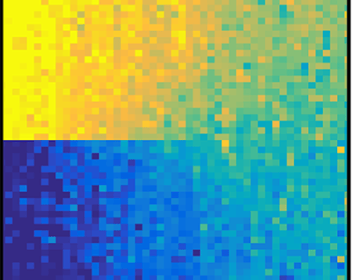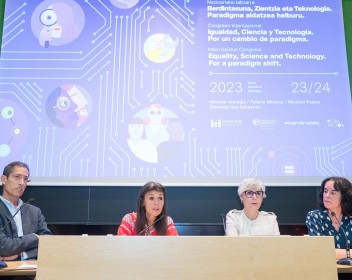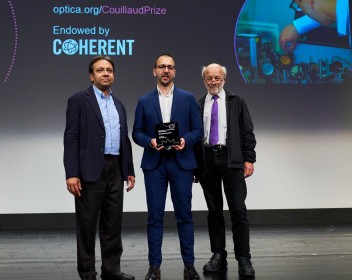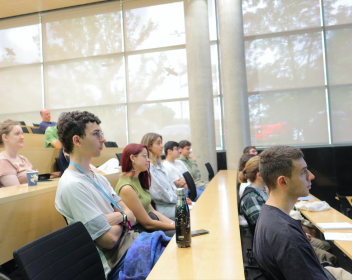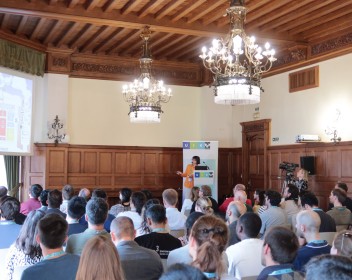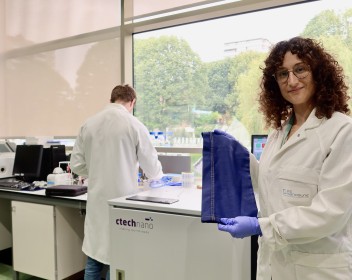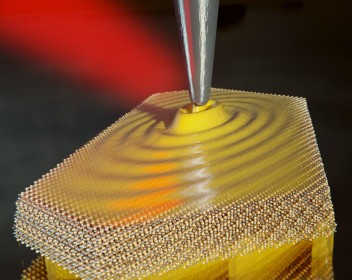Sala de prensa
Noticias
Nuevo equipamiento científico adquirido en el marco del programa Azpitek del Gobierno Vasco
Representantes del Gobierno Vasco y de los centros tecnológicos y de investigación de la alianza BRTA, Basque Research and Technology Alliance, visitan los laboratorios de nanoGUNE para conocer de primera mano los nuevos equipos adquiridos gracias a la financiación del programa Azpitek del Gobierno Vasco.
Da comienzo el Congreso Internacional 'Igualdad, Ciencia y Tecnología, por un cambio de paradigma'
Critical Scaling of Dynamic Phase Transitions in magnetic films
In a recent article published in Physical Review Letters (Phys. Rev. Lett. 131, 116701 (2023)) and selected as an Editor’s suggestion, Mikel Quintana and Andreas Berger from the Nanomagnetism group at nanoGUNE succeeded in experimentally detecting and quantifying critical scaling near the dynamic phase transition (DPT) for the first time.
Presentan el Congreso Internacional "Igualdad, Ciencia y Tecnología, por un cambio de paradigma"
La consejera de Igualdad, Justicia y Políticas Sociales, Nerea Melgosa, y la directora de Emakunde, Miren Elgarresta, han presentado en el centro CIC nanoGUNE, acompañadas por el director de nanoGUNE Txema Pitarke y la directora de identidad digital de la Universidad de Deusto Lorena Fernández, el Congreso Internacional “Igualdad, Ciencia y tecnología, por un cambio de paradigma” que se celebrará los próximos días 23 y 24 de octubre en el Palacio Miramar de Donostia. El Lehendakari Iñigo Urkullu será el encargado de inaugurar un congreso que reunirá a personas expertas a nivel internacional de cara a abordar las desigualdades y brechas de género existentes y las transformaciones necesarias para incorporar de forma sistémica la igualdad de mujeres y hombres en el ámbito de la ciencia y la tecnología.
La empresa tecnológica vasca MYRUNS se convierte en socia mayoritaria de la biotecnológica Evolgene Genomics
MYRUNS ENGINEERING SPORTS, SL (MYRUNS) empresa vasca liderada por su fundador y mayor accionista, Xabier García Roldán, y dedicada al desarrollo de soluciones para la digitalización de empresas mediante tecnología de Identificación por Radiofrecuencia (RFID, de sus siglas en inglés), ha adquirido el 80% de la también vasca Evolgene Genomics, spin-off del centro de investigación cooperativa en nanociencia CIC nanoGUNE.
Edoardo Vicentini, ganador del premio Bernard J. Couillaud 2023
¡Damos la bienvenida a los estudiantes de prácticas en CIC nanoGUNE!
CIC nanoGUNE organiza la primera escuela de verano de Nanoscopía Óptica de Campo Cercano
"Cuando desarrollamos las herramientas de nanoimagen óptica s-SNOM y nano-FTIR, nunca pensé que pudieran tener un potencial de aplicación tan amplio", afirma el Profesor de Investigación Ikerbasque Rainer Hillenbrand cuando es preguntado por la evolución de su campo de investigación. Esta semana, del 6 al 9 de junio, la escuela de verano de Nanoscopía Óptica de Campo Cercano que han organizado desde nanoGUNE junto con Ensemble3 y Attocube, acogerá a más de 70 participantes deseosos de aprender a sacar el máximo partido a estas técnicas.
Una tecnología desarrollada en CIC nanoGUNE impulsa la innovación en el sector textil
El centro vasco de investigación en nanociencia CIC nanoGUNE está desarrollando técnicas específicas para funcionalizar fibras y tejidos de la industria textil. Esta prometedora línea de investigación, liderada por el grupo de Nanomateriales, se enmarca dentro de un proyecto Elkartek en el que participan también el centro tecnológico Gaiker que testea las propiedades finales de las telas tratadas— y la empresa textil Andromeda Moto que proporciona las telas .
Researchers observe extremely squeezed directional THz waves in thin semiconductor crystals
An international team of scientists from the Basque research center CIC nanoGUNE, Shanghai University for Science and Technology, Fudan University (Shanghai), Brno University of Technology, University of the Basque Country, Materials Physics Center (CSIC-UPV/EHU), Donostia International Physics Center and the Max Planck Institute for Chemical Physics of Solids (Dresden) has imaged and analyzed THz waves that propagate in form of plasmon polaritons along thin anisotropic semiconductor platelets with wavelengths reduced by up to 65 times compared to THz waves in free space. What´s even more intriguing is that the wavelengths vary with the direction of propagation. Such THz waves can be applied for probing fundamental material properties at the nanometer scale and pave the way to the development of ultra-compact on-chip THz devices. The work has been published in Nature Materials (DOI: 10.1038/s41563-023-01547-8).
Agenda
| Lun | Mar | Mié | Jue | Vie | Sáb | Dom |
|---|---|---|---|---|---|---|
|
1
|
2
|
3
|
4
|
5
|
6
|
7
|
|
|
|
|
|
|
|
|
|
8
|
10
|
11
|
12
|
13
|
14
|
|
|
|
|
|
|
|
|
|
|
15
|
16
|
17
|
18
|
19
|
20
|
21
|
|
|
|
|
|
|
|
|
|
22
|
23
|
24
|
25
|
26
|
27
|
28
|
|
|
|
|
|
|
|
|
|
29
|
30
|
31
|
1
|
2
|
3
|
4
|
|
|
|
|
|
|
|
|
Eventos
- 04/02/2026 al 06/02/2026
nanoGUNE Winter School 2026
nanoTECA
Encuentra fotos, imágenes experimentales, vídeos, audios y elementos de la imagen corporativa de nanoGUNE.

